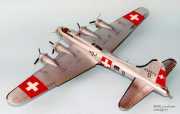
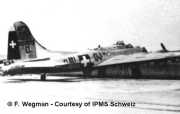
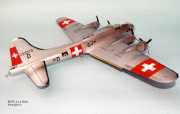
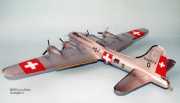
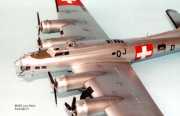
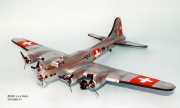






| IL SOGGETTO
Non servono presentazioni per il più noto bombardiere impiegato dall'USAAF in Europa durante il secondo conflitto mondiale. Operando dagli aeroporti britannici i B-17 hanno svolto, assieme ai più capienti B-24, gran parte delle missioni di bombardamento strategico. L'esemplare da me realizzato fa parte di una collezione di ben 12 B-17, presentata dal Centro Modellismo IPMS Milano alla 23^ Mostra-Concorso Nazionale presso la fiera Hobby Model Expo 2000. Il 13 aprile 1944, durante una missione di bombardamento sul sud della Germania, il Boeing B-17G-35-BO matricola 42-32073 atterrava in territorio elvetico per cause non note ma intuibili. Mentre i membri del suo equipaggio finivano poco eroicamente la guerra come internati, le Truppe di Aviazione Svizzere requisirono il velivolo intatto. Esso venne quindi valutato e rimase operativo presso la Flugwaffe fino al tardo 1945. |
SUBJECT
There is no need to introduce the best known USAAF's bomber in Europe during the Second World War. Departing from British airfields, B-17s carried out most of the strategic bombing missions, aside the most capable B-24s. The esample I modelled belongs to a collection of 12 B-17s that my modelling club put on exhibit at Italian IPMS nationals in September 2000. On April, 13, 1944, during a bombing mission on southern Germany, Boeing B-17G-35-BO bu.no.42-32073 landed in a Swiss airfield for unknown but easily understandable reasons. While the crew prematurely ended their war as POWs to Switzerland, Swiss Air Troops requisited the intact aircraft. It was then evaluated and held in use by the Flugwaffe until late 1945. |
| IL MODELLO
Benché questo non fosse un progetto pianificato a breve termine, quando con gli amici del mio gruppo modellistico si trattò di decidere il tema della "collezione tematica" per il 2000, mi ricordai di questo soggetto, votai per il B-17 e la proposta fu accolta. Per la documentazione mi ero già rivolto a suo tempo agli amici dell'IPMS Svizzera, di cui ringrazio in particolare Rolf Blattner e F.Wegmann, ai quali devo il lavoro di ricerca storica da me utilizzato. Il kit usato è un B-17G Hasegawa in scala 1:72, appositamente acquistato, privo di scatola e di decals ma ad un prezzo irrisoro, da una simpaticissima modellista americana, conosciuta tramite internet, che "traffica" in questo tipo di mercanzie. L'assemblaggio del modello non ha richiesto particolari modifiche, eccezion fatta per la postazione del mitragliere laterale di fusoliera destro. Come si vede dalla foto del velivolo originale, essa era in posizione più arretrata di quella presente nel kit, perciò ho dovuto spostarla aiutandomi con stucco e colla cianoacrilica per eliminare i segni della modifica. Per le decalcomanie, avendo disegni e foto del soggetto originale ho fatto ricorso a strumenti grafici computerizzati compe quelli che uso per le Alpsdecals, anche se per le croci elvetiche su ali e fusoliera ho preferito ricorrere alle tradizionali mascherature ed all'aerografo. Qualche attenzione in più è servita per l'emblema sulla deriva: una "C" bianca racchiusa in un quadrato nero, solo parzialmente cancellata da una leggera mano di vernice color alluminio. Per realizzarla sul modello ho usato lo stesso metodo. Per quanto riguarda l'"invecchiamento" ho applicato un legero lavaggio con del petrolio bianco sporcato di colore ad olio nero e marrone. Una passata ad aerografo di colore acrilico trasparente, ben diluito ed anch'esso sporcato appena di nero, hanno fatto il resto. |
MODEL
Alhough not a planned project, when fellow modellers at my club were to decide the theme of the "group collection" for the 2000 exhibit, this subject came to my mind, I voted for the B-17 and this choice was accepted. I already had a good documentation supplied by some members of IPMS Switzerland, Rolf Blattner and F. Wegmann in particular. I used a 1:72 scale B-17G kit from Hasegawa, purchased on purpose as a bargain (missinig box and decals) from a very pleasant American woman who runs a home based business trading second hand model kits. Assembly went on smooth but I had to move the right rear fuselage side gunner's windows since the kit depicted the offset windows version while pictures showed that the Swiss bird had the symmetrical ones. Then I used filler and superglue to hide modification marks. Having good drawings and pictures of the original,.markings.were made at the computer with Alpsdecals but I still made use of maskings and airbrush for the huge white crosses on wings and fuselage sides. I had to put some extra efforts for the tail "C" emblem, painted in white over a black square but partially cancelled with aluminium dyed paint. I used the same method on the model. The weathering was obtained by mean of a white petroleum wash with some black and brown oil artist colors added. Further effects like smoke strains were made with thinned and airbrushed matt acrylic varnish mixed with two drops of black. |
Ritorna
alla galleria dei modelli di Luca Beato
back
to index